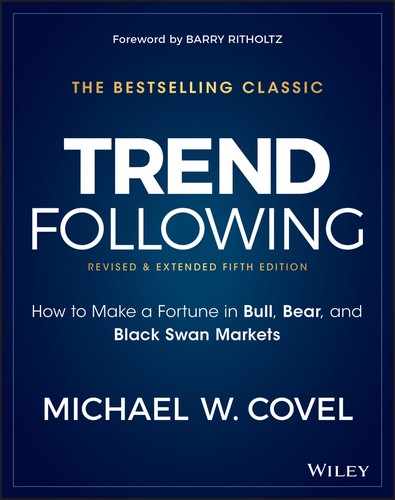Section III
Trend Following
Research
Academicians settled on volatility as the proxy for risk as a
matter of convenience. They needed a number for their calculations that was objective and could be ascertained historically and extrapolated into the future. Volatility fits the bill, and most of the other types of risk do not. The problem with all of this, however, is that I just don’t think volatility is the risk most investors care about. Rather than volatility, I think that people decline to make investments primarily because they’re worried about a loss of capital or an unacceptably low return. To me, “I need more upside potential because I’m afraid I could lose money” makes an awful lot more sense than “I need more upside potential because I’m afraid the price may fluctuate.” No, I’m sure “risk” is—first and foremost—the likelihood of losing money. —Howard Marks1 If you talk to these extraordinary people, you find that they all understand this at one level or another. They may be unfamiliar with the concept of cognitive adaptability, but they seldom buy into the idea that they have reached the peak of their fields because they were the lucky winners of some genetic lottery. They know what is required to develop the extraordinary skills that they possess because they have experienced it firsthand. Anders Ericsson2 I never know where connective tissue to make a case for trend following will be found. It’s always serendipity. For example, Bob Seawright was a guest on my podcast (episode #328) and he has this great blog passage that I admire: American virologist David Baltimore, who won the Nobel Prize for Medicine in 1975 for his work on the genetic mechanisms of viruses, once told me that over the years (and especially while he was president of CalTech) he received many manuscripts claiming to have solved some great scientific problem or to have overthrown the existing scientific paradigm to provide some grand theory of everything. Most prominent scientists have drawers full of similar submissions, almost always from people who work alone and outside of the scientific community. Unfortunately, none of these offerings has done anything remotely close to what was claimed, and Dr. Baltimore offered some fascinating insight into why he thinks that’s so. At its best, he noted, good science is a collaborative, community effort. On the other hand, crackpots work alone.3 Since I like to think of myself as no crackpot, this new section of Trend Following lays bare in detail a collaborative and community effort. Each of the following research papers adds new value and clarification to my main text and interviews.
